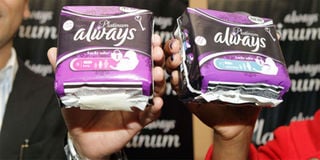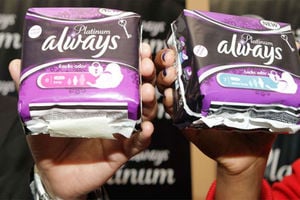
Procter and Gamble Always sanitary pads.
The High Court has pushed to next year a petition seeking to compel two manufacturers to provide accurate information regarding the materials used in the production of sanitary pads, tampons, panty liners and diapers.
High Court judge Chacha Mwita on Tuesday scheduled the hearing of the case filed by lawyer Joseph Mwai for March 24, 2025, after directing the city lawyer and the manufacturers, Procter & Gamble, as well as Kimberly-Clark, to exchange their court documents.
In the petition, Mr Mwai accuses the two American manufacturers of engaging in misleading advertising by falsely claiming that their sanitary pads and diapers are made from cotton or cotton-like materials, yet they are allegedly made from synthetic materials.
The lawyer said the firms are culpable for making false representations contrary to Section 12(1) of the Consumer Protection Act, as they have engaged in misleading advertisement.
Mr Mwai further said the manufacturers have failed to disclose critical information regarding the synthetic materials used in their products.
“By omitting this information, they have acted in bad faith, prioritising profits over consumer welfare and safety. This breach of transparency is indicative of a deliberate strategy to obscure the truth from consumers, thereby undermining their ability to make informed choices,” he said in the petition.
Mr Mwai said P&G marketed their 'Always Ultra' sanitary pads with the tagline "soft like cotton," despite the pads containing synthetic materials rather than actual cotton.
He said the misrepresentation creates the impression that the pads have qualities or cotton ingredients, which they do not actually have.
The lawyer said Kimberly-Clark has been marketing ‘Huggies’ diapers with an emphasis on comfort and softness, implying the use of high quality materials such as cotton, while in reality, they are using numerous synthetic substitutes.
He wants the court to direct the manufacturers to remove from the market all products that do not provide accurate information regarding the materials used.
The petitioner claims that from the list of ingredients provided, which includes complex chemical compounds such as Polyoxyalkylene, Substituted Chromophores, PEG Sorbitol Hexaoleate, Wood Pulp, Polypropylene, Polyethylene, Polyurethane elastics, Polyolefin Elastic and Ethylene Vinyl Acetate Copolymer, among many others, demonstrates the inherent difficulty for the average consumer to comprehend the true nature and potential health implications of these materials.
Mr Mwai added that the use of technical jargon and unfamiliar terms creates a significant barrier to deciding and understanding, leaving consumers vulnerable and unable to make informed decisions about the products they use on a daily basis, particularly in sensitive areas of the body.
He pointed out that the companies manufacture, market, and distribute sanitary pads, tampons, panty liners and diapers under the brand names Always, Pampers, Huggies and Kotex, among others.
“The Petitioner brings this suit on their behalf and on behalf of their family, as a father, uncle, brother, cousin, grandfather and on behalf of all women and children within the class of consumers who have suffered and continue to suffer similar grievances, pursuant to Section 5 of the Consumer Protection Act,” he said.
Mr Mwai said that given that these products are designed for prolonged use, any harmful or misleading ingredients pose significant risks to the health and well-being of consumers, especially women and children.






